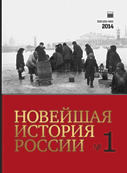Свободная Трудовая Церковь (1922–1925 гг.): из истории обновленческого движения в русском православии первой половины ХХ в.
The Free Labour Church (1922–1925): From History of the Renovationist Movement in Russian Orthodoxy during the first half of the 20th century
Author(s): Mihail Yurevich KrapivinSubject(s): History
Published by: Издательство Исторического факультета СПбГУ
Keywords: Orthodox Church; Free Labour Church; Renovationist Movement
Summary/Abstract: The article is devoted to the history of the Free Labour Church (FLC), which was created in Moscow in 1922 by three people: the well-known poet and anarchist Alexander Svyatogor; Fyodor Zhilkin, a former assistant of the priest Georgii Gapon, who later (1917–1919) became the chairman of the Christian and Socialist Workers' and Peasants' Party; and Ivan (Loannikii) Smirnov, one of the organizers of the “Penza Church Schism” (1918–1921) who was also a close associate of Archbishop Vladimir (Putiata). The emergence and development of the FLC is reconstructed in this article. Biographical data on the founders of the FLC is detailed, and their religious and political views are characterized. Attention is cast toward the relationship between the FLC and the Soviet state, including relations with the state security agencies (VChK–GPU–OGPU). The FLC’s role in the Orthodox Renovationist movement during the first half of the 1920's is also clarified. Originally (in late 1922 – early 1923), Soviet authorities regarded the FLC as offering an additional way to disrupt the ranks of the Russian Orthodox Church and weaken the power of the Moscow patriarchy. However, the First Renovationist Council (during the Spring of 1923) refused to recognize a number of small Renovationist groups such as the FLC and encouraged them to disband. The FLC ignored these recommendations. Then, the GPU began to pursue the gradual neutralization of the FLC (insofar as it undercut Soviet state religious policy and interfered with the Orthodox Renovationist movement). For this reason, when the FLC tried to register as a religious association in the summer of 1923, it was denied official recognition. This article analyzes the program and charter of the FLC. These materials testify to the radical nature of its ideologists and leaders, who wished for the FLC to become a religious movement that would extend beyond the boundaries of even reform Orthodoxy. Believers, who early on had been concerned about how the FLC’s texts were printed in the central Soviet newspapers (1923–1924), subsequently left the organization when it rejected not only traditional hierarchical structures, orthodox sacraments and ceremonies, but also rejected the canons and doctrines of the Orthodox Church. This turned the FLC, in the believers’ minds, “into a simple appendage to communism".
Journal: Новейшая история России
- Issue Year: 4/2014
- Issue No: 09
- Page Range: 90-107
- Page Count: 18
- Language: Russian

